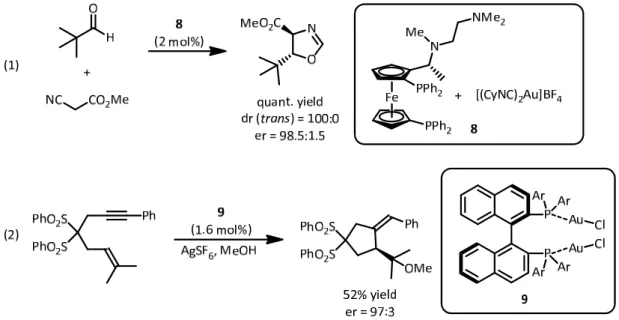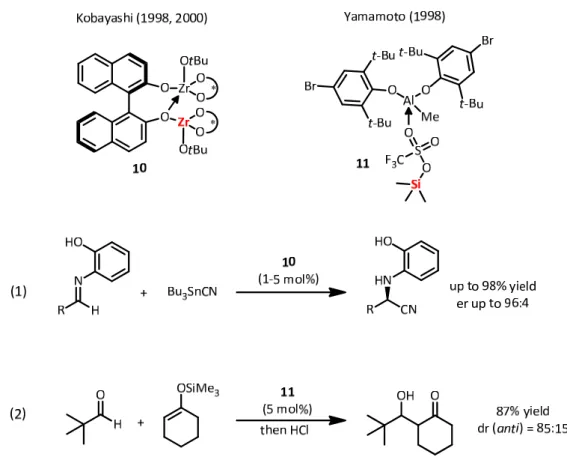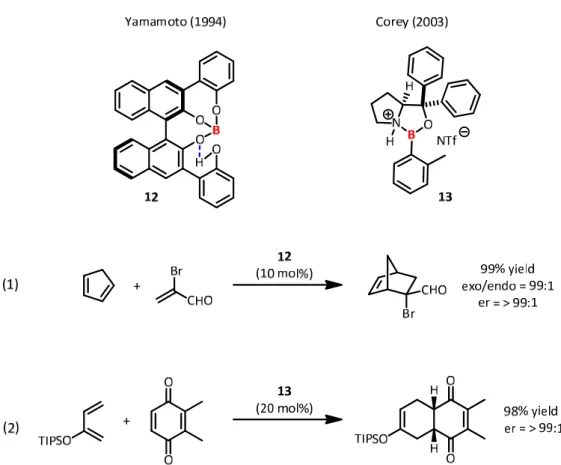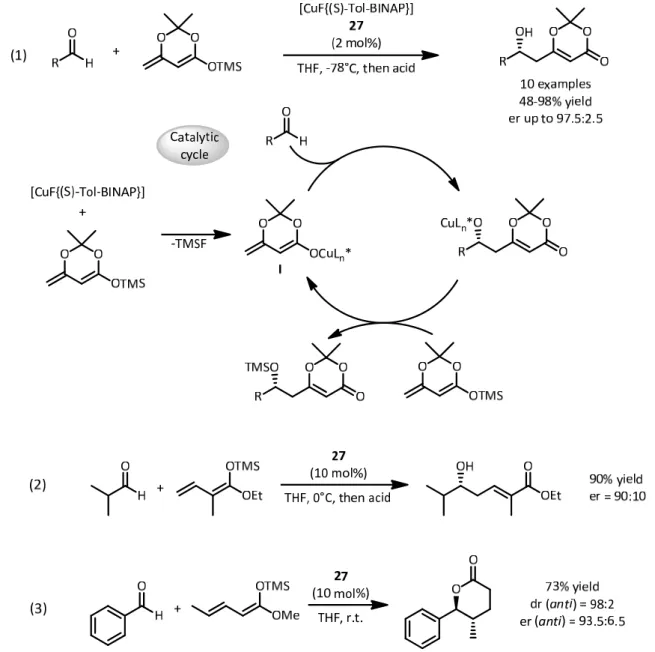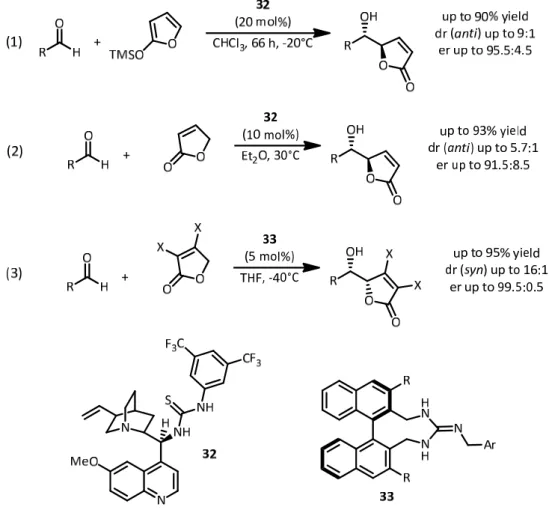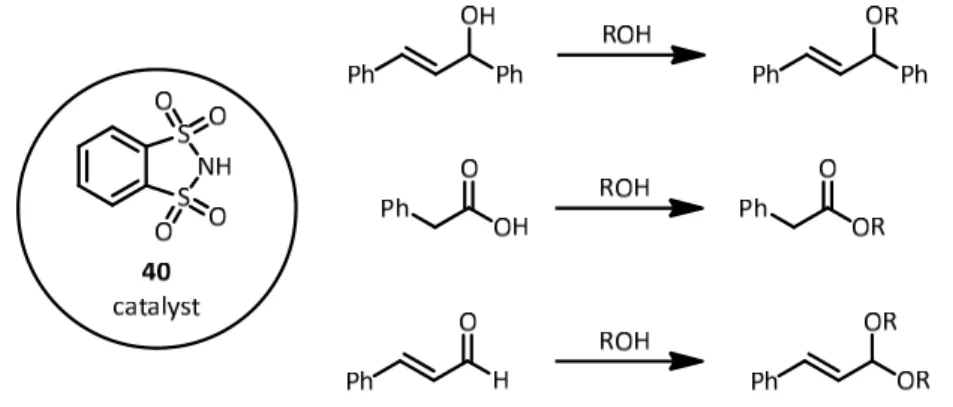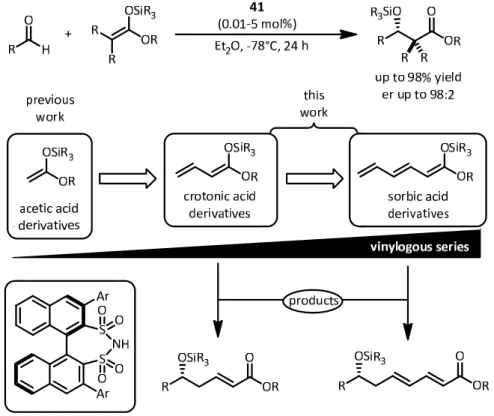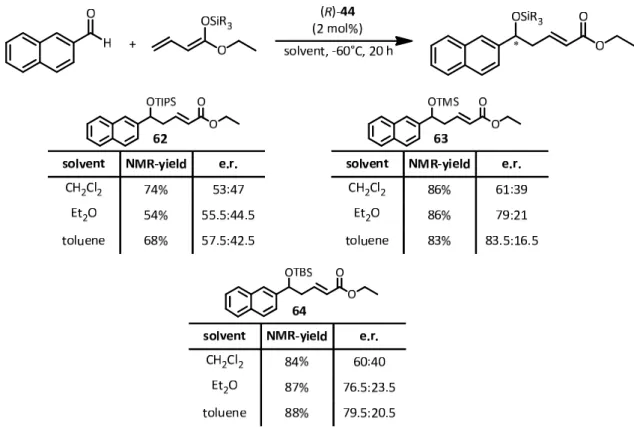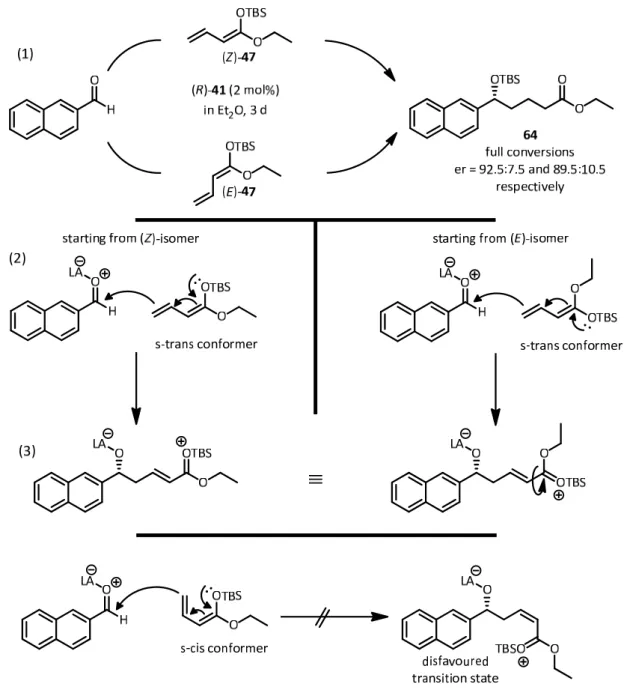— Organic Lewis Acid Catalysis — Vinylogous Mukaiyama Aldol Reactions
And New Catalysts
Inaugural‐Dissertation
zur
Erlangung des Doktorgrades
der Mathematisch–Naturwissenschaftlichen Fakultät der Universität zu Köln
vorgelegt von Lars Ratjen aus Brake (Unterweser)
Berichterstatter: Prof. Dr. Benjamin List
Prof. Dr. Axel G. Griesbeck
Tag der mündlichen Prüfung: 24.01.2012
______________________________________
„Die Menschen sind verschieden, doch die Wahrheit ist Eine, und alle, die sie suchen, auf welchem Gebiet es sei, helfen einander.“
Gottfried Wilhelm Freiherr von Leibniz (1646‐1716)
(loose transl.: Humans are different, but the truth is One, and all seeking for it, in whatever field, are helping each other.)
______________________________________
______________________________________
„Viele sind hartnäckig in Bezug auf den einmal eingeschlagenen Weg, wenige in Bezug auf das Ziel.“
Friedrich Nietzsche (1844‐1900)
(loose transl.: Many are insistent regarding the way they took, few regarding the goal.)
______________________________________
The work presented in this doctoral thesis was conducted between October 2007 and December 2011 at the Max‐Planck‐Institut für Kohlenforschung in Mülheim an der Ruhr, under the guidance of Prof. Dr. Benjamin List.
Danksagung / Acknowledgments
I am indepted to Prof. Dr. Benjamin List, who offered me the great opportunity to work in his laboratories. I really appreciated the exciting and challenging research topic and the trust, motivation, freedom and support he showed to me.
My thanks go to Prof. Dr. Axel G. Griesbeck for accepting the assignment as second referee.
I am much obliged to Olga Lifchits, Dr. Kevin Jones, Ji‐Woong Lee, Dr. Alberto Martinez Cuezva, Dr. Joyram Guin and Dr. Martin Klußmann for carefully proof‐reading this manuscript.
Thanks to all the past and present members of the List‐group, including Klußmann‐ and Maulide‐labs, for the excellent time I had and the friendships I made. The atmosphere, cooperation and fun we shared are irreplaceable and I will keep you in good memory.
For the excellent collaboration in some projects contained in this thesis, I want to thank Dr.
Pilar García García, furthermore Caroline Gawlik, Frank Lay, Dr. Michael Edmund Beck (Bayer CropScience), Dr. Alberto Martinez Cuezva and Manuel Mahlau.
For fruitful discussions and exchange regarding our “beloved” catalysts reported here, I also want to mention Dr. Joyram Guin, Manuel Mahlau and Dr. Shikha Gandhi for being so passionate and dedicated.
I want to acknowledge the complete technician‐team, without these people the great organization in the lab would be impossible. Special thanks go to Marianne Hannappel, Simone Marcus and Pascal Walkamp. Furthermore I want to thank Adrienne Hermes for organizing our life inside and outside the labs.
My gratitude needs to be expressed to the analytical departments of the Max‐Planck‐Institut für Kohlenforschung, namely the HPLC‐, NMR‐, MS‐, GC‐ and X‐Ray‐departments. Here my special thanks go to Heike Hinrichs, Petra Philipps, Georg Breitenbruch, Alfred Deege and Dr.
Christophe Farés for fantastic collaborations and help in several problems.
I want to thank Sanofi‐Aventis (Frankfurt, Paris) and especially Priv.‐Doz. Dr. Heiner Jendralla
(Frankfurt) for funding and for sharing joint projects during the first part of my time as a
doctoral student. Although the results obtained are not reflected on these pages, I appreciated the collaboration in all its facettes.
Since the time outside the lab can be equally nice and fruitful, I want to thank all the people I met in this institute which turned into real friends, sometimes even into more. It was a great joy to get to know you: Steffen Müller (Danke für alles!!!), Arnaud Ladepeche, Patricia García García, Manuel Alcarazo Velazco, Constantinos Rampalakos, Pilar García García, Matthew Webber, Alberto Martinez Cuezva and Loreto Paulina Parra Atala. Thanks for the time we shared and will share in the future.
Mein allergrößter Dank gilt meiner Familie: meinen Eltern und meinem Bruder. Ohne Euch wäre ich nicht hier angekommen! Danke für Eure Hilfe, Geduld und Unterstützung, auch wenn ich Euch nie wirklich anschaulich erklären konnte was ich eigentlich mache. Ich fürchte diese Arbeit hilft dabei auch nicht besonders…
Meiner Familie, ohne die diese Arbeit nicht möglich gewesen wäre.
Meinen Kollegen, ohne die ich diese Arbeit nicht geschafft hätte.
Meinen Freunden, ohne die ich diese Arbeit nicht überstanden hätte.
Gracias Lolo. Te quiero!
Outline
Outline
Abbreviation Index ... ‐ 1 ‐
1. Introduction ... ‐ 3 ‐
2. Background ... ‐ 6 ‐
2.1 Lewis Acid Catalysis in organic synthesis ... ‐ 6 ‐
2.1.1 σ‐Lewis acids ... ‐ 8 ‐
2.1.2 π‐Lewis acids ... ‐ 12 ‐
2.1.3 Cooperative effects in Lewis‐acid catalysis ... ‐ 14 ‐
2.2 Aldol reactions ... ‐ 17 ‐
2.2.1 Stereoselectivity in aldol reactions ... ‐ 18 ‐
2.2.2 Mukaiyama‐type aldol reactions ... ‐ 20 ‐
2.3 Vinylogous Mukaiyama aldol reactions (VMARs) ... ‐ 27 ‐
2.3.1 The principle of vinylogy ... ‐ 27 ‐
2.3.2 Vinylogy in stereoselective aldol reactions ... ‐ 28 ‐
2.4 Silicon Lewis‐acids for aldol reactions ... ‐ 34 ‐
2.4.1 Silylated Brønsted acids as powerful Lewis acids ... ‐ 35 ‐
2.4.2 Lewis base activation of Lewis acids ... ‐ 38 ‐
2.4.3 Disulfonimides as powerful Lewis acid pre‐catalysts ... ‐ 40 ‐
3. Research Goals ... ‐ 44 ‐
3.1 Towards an efficient protocol of metal‐free catalyzed vinylogous and double vinylogous Mukaiyama aldol reactions ... ‐ 44 ‐
3.2 Mechanism elucidation and development of more efficient disulfonimide‐ catalysts ... ‐ 45 ‐
3.3 Development of improved disulfonimide‐catalysts ... ‐ 47 ‐
Outline
4. Results and Discussion ... ‐ 48 ‐
4.1 Disulfonimide‐catalyzed vinylogous Mukaiyama aldol reactions ... ‐ 48 ‐
4.1.1 Synthesis of crotonic‐acid derived nucleophiles ... ‐ 48 ‐
4.1.2 Synthesis of alternative nucleophiles ... ‐ 50 ‐
4.1.3 Optimization of the disulfonimide‐catalyzed VMAR ... ‐ 51 ‐
4.1.4 Disulfonimide‐catalyzed VMAR – Nucleophile scope ... ‐ 62 ‐
4.1.5 Disulfonimide‐catalyzed VMAR – Electrophile scope ... ‐ 64 ‐
4.2 Disulfonimide‐catalyzed double vinylogous Mukaiyama aldol reactions (DVMAR) ... ‐ 68 ‐
4.2.1 Synthesis of sorbic acid‐derived nucleophiles ... ‐ 68 ‐
4.2.2 Theoretical studies towards the nucleophilic behaviour of silyl trienolates ... ‐ 70 ‐
4.2.3 The disulfonimide‐catalyzed DVMAR ... ‐ 73 ‐
4.2.4 Determination of the absolute configuration ... ‐ 80 ‐
4.2.5 Synthetic application of the double vinylogous Mukaiyama aldol reaction ... ‐ 82 ‐
4.2.5.1 Synthesis of eigth‐membered ring lactones (ζ‐lactones) ... ‐ 83 ‐
4.3. Mechanism Elucidation ... ‐ 85 ‐
4.3.1 Preliminary studies towards establishing the reaction mechanism ... ‐ 85 ‐
4.4 Catalyst improvement by means of cooperative effects ... ‐ 95 ‐
4.4.1 Synthesis and theroretical investigations of hydroxy‐disulfonimides ... ‐ 95 ‐
5. Summary ... ‐ 110 ‐
6. Outlook ... ‐ 116 ‐
6.1 Possible applications of double vinylogous aldol reactions ... ‐ 116 ‐
6.2 Potential developments in disulfonimide‐catalysis ... ‐ 116 ‐
6.3 The future of metal‐free Lewis acid catalysis ... ‐ 119 ‐
Outline
7. Experimental part ... ‐ 122 ‐
7.1. General Remarks ... ‐ 122 ‐
7.2. Vinylogous Mukaiyama aldol reactions (VMAR) ... ‐ 125 ‐
7.2.1 Synthesis of dienolates for VMARs ... ‐ 125 ‐
7.2.2 Catalytic asymmetric VMARs ... ‐ 136 ‐
7.3 Double vinylogous Mukaiyama aldol reactions (DVMARs) ... ‐ 162 ‐
7.3.1 Synthesis of trienolates for DVMARs ... ‐ 162 ‐
7.3.2 Towards the nucleophilicity of silyl enolates, dienolates and trienolates ... ‐ 169 ‐
7.3.3 Catalytic asymmetric DVMARs ... ‐ 172 ‐
7.3.4 Synthesis of a 4‐nitrophenyl‐derivative of 121 ... ‐ 192 ‐
7.3.5 The synthesis of ζ‐Lactones from DVMAR‐products ... ‐ 194 ‐
7.3.5.1 Synthesis of lactone 132: 8‐(Naphthalen‐2‐yl)oxoctan‐2‐one ... ‐ 194 ‐
7.3.5.2 Synthesis of lactone 137: 8‐(4‐Bromo‐3,5‐dimethoxyphenyl)oxocan‐2‐one.... ‐ 198 ‐
7.3.5.3 Synthesis of lactone 141: 8‐(tert‐Butyl)oxocan‐2‐one ... ‐ 201 ‐
7.4 NMR‐, and scrambling‐experiments ... ‐ 204 ‐
7.4.1 Experiments corresponding to Fig. 87 ... ‐ 204 ‐
7.4.2. Experiments corresponding to Fig. 88 ... ‐ 206 ‐
7.4.3 Experiments corresponding to Fig. 89 and Fig. 90 ... ‐ 208 ‐
7.5 Synthesis of new catalysts ... ‐ 210 ‐
7.5.1 Preparation of hydroxy‐disulfonimides: ... ‐ 210 ‐
7.5.2 Synthesis of challenging VMAR and DVMAR‐products ... ‐ 214 ‐
7.5.3 Synthesis of an electron‐poor ketone substituent for hydroxy‐disulfonimides .. ‐ 216 ‐
7.5.4 Synthesis of an achiral hydroxy‐disulfonimide ... ‐ 219 ‐
7.5.5 Preparation of the precursor for Methallenestril ... ‐ 222 ‐
7.5.6 Synthesis of a hydroxy‐phosphoric acid ... ‐ 223 ‐
Outline
7.5.7 Preparation of carbon‐based Brønsted‐acid‐precursors and ‐catalysts ... ‐ 224 ‐
8. Bibliography ... ‐ 228 ‐
9. Appendix ... ‐ 236 ‐
9.1 Crystallographic data ... ‐ 236 ‐
9.2 Abstract / Kurzzusammenfassung ... ‐ 263 ‐
9.3 Erklärung ... ‐ 264 ‐
9.4 Lebenslauf... ‐ 265 ‐
Abbreviation Index
Abbreviation Index
A – anion or acid E – electrophile
Å – Ångström (E) – double bond geometry (entgegen) Ac – acetyl EDG – electron donating group
ACDC – asymmetric counteranion EI – electron ionization
directed catalysis eq – equation
Alk – alkyl equiv – equivalents/equivalent Ar – aryl, aromatic er – enantiomeric ratio
BINAP – (2‐2’‐Bis(diphenylphosphino)‐ ESI – electospray ionization
1,1’‐binaphthyl EWG – electron withdrawing group
BINOL – 1,1’‐bi‐2‐naphthol F
‐– source of fluoride Bn – benzyl GC – gas chromatography
Boc – tert‐butyloxycarbonyl GSP – general synthetic procedure c – concentration h – hours
C – cation HMPT – hexamethylphosphoric triamide calcd. – calculated HOMO – highest occupied molecular orbital cat. – catalyst/catalytic HPLC – high performance liquid chromatography CFF – condensed fukui function HRMS – high resolution mass spectrometry CI – chemical ionization HSAB – hard/soft, acid/base‐theory
Cy – cyclohexyl ∫ – integral (NMR)
d – days IR – infrared spectroscopy
δ – chemical shift (NMR) KHMDS – potassium hexamethyldisilazide
Δ – heat L – ligand
dba – dibenzylideneacetone LA – Lewis acid DCC – dicyclohexylcarbodiimide LB – Lewis base
DFT – density functional theory LC – liquid chromatography DMAP – 4‐dimethylaminopyridine LDA – lithium diisopropylamide DMF – dimethylformamide lit. – literature
DMPU – 1,3‐dimethyl‐3,4,5,6‐tetrahydro‐ LUMO – lowest unoccupied molecular
2(1H)‐pyrimidinone orbital
DMSO – dimethylsulfoxide m‐ – meta‐position
dr – diastereomeric ratio M – mass or metal
DVMAR – double VMAR M – molarity
Abbreviation Index
MM – molecular mechanics TRIP – 3,3’‐bis(2,4,6‐triisopropylphenyl)‐1,1’‐
MS – mass spectrometry binaphthyl‐2,2’‐diylhydrogenphosphate NCS – N‐chlorosuccinimide Ts – tosyl
n.d. – not detected UV – ultraviolet
neg – negative VMAR – vinylogous Mukaiyama aldol reaction NMR – nuclear magnetic resonance X – electronegative group
spectroscopy (Z) – double bond geometry (zusammen) NOE – nuclear Overhauser effect
Nu – nucleophile
o‐ – ortho‐position
p‐ – para‐position
P – product
PCC – pyridiniumchlorochromate
Ph – phenyl
pos – positive
ppm – parts per million PyBox – 2,6‐bis(oxazolin‐2‐yl)pyridine quant. – quantitative
R – rest
r.t. – room temperature SM – starting material TBS – tert‐butyl(dimethyl)silyl Tf – trifluoromethanesulfonyl THF – tetrahydrofuran TIPS – triisopropylsilyl TLC – thin layer chromatography
TMEDA – N,N,N’,N’‐tetramethylethylenediamine TMS – trimethylsilyl
TOF – turnover frequency (per hour)
Tol – tolyl
TON – turnover number
Tr – trityl
1. Introduction
1. Introduction
Chirality is ubiquitous in nature, embodied for example in the interaction of optically pure drugs with its binding sites. This phenomenon is called molecular recognition and its fundamentals were first discussed as “Schlüssel‐Schloss‐Prinzip – (key‐lock‐principle)” by Emil Fischer in 1894 (Fig. 1).
[1]Figure 1. Illustration of the key lock principle and chirality.
Thus it was not surprising, that an interest in the production of enantiomerically enriched products developed very early: asymmetric synthesis.
[2]Asymmetric synthesis in general, and asymmetric catalysis in particular, ranks among the most stimulating and challenging concepts in organic chemistry. Since countless organic transformations can be conducted in an asymmetric way, its possibilities are truly manifold.
[3]To develop a successful method, one has to consider various parameters, eventually encountering new reaction mechanisms and opening up unknown pathways. Almost infinite numbers of contributions make it one of the most fruitful areas of scientific research, a steadily growing pool of solutions to almost any problem one might face in synthesis and catalysis.
[4]Summoning early studies by Louis Pasteur
[5]and Emil Fischer, Willi Marckwald carved the
cornerstone of asymmetric synthesis in 1904.
[6]Reacting achiral ethylmethylmalonic acid 1
with enantiomerically pure brucine, he obtained a mixture of salts which were separable by
crystallization. Selecting the crystals of one enantiomerically pure salt, decarboxylating the
free carboxylic acid function and subsequently hydrolizing, he was able to isolate optically
active 2‐methyl‐butanoic‐acid 2. As such, the transformation achieved enantioenrichment
during the reaction pathway, an asymmetric synthesis (Fig. 2).
1. Introduction
Figure 2. First asymmetric synthesis by Marckwald.
Reviewing his achievements, Marckwald described asymmetric syntheses as follows:
“Asymmetrische Synthesen sind solche, welche aus symmetrisch constituirten Verbindungen unter intermediärer Benutzung optisch‐activer Stoffe, aber unter Vermeidung jedes analytischen Vorganges, optisch‐active Substanzen erzeugen.”
[7](loose transl.: Asymmetric syntheses are those which convert symmetrically substituted compounds, under the governance of optically active substances and avoiding any analytic operation, into optically active substances.)
The key attribute of operational simplicity was already present in the very first definition. In this context it seems inconsistent, that many catalytic systems developed for asymmetric organic synthesis, approach the addressed problem on a level which eliminates operational simplicity in the root. Surely numerous contributions to asymmetric catalysis are very appealing and bear a non‐dismissible beauty, however their successful synthetic application at low cost, as the ultimate goal in organic synthesis, is unlikely. Quality and financial demands for compounds in pharmaceutical‐, crop‐protection‐, material‐ or food‐industry forbid impurities (both with undesired compounds and the wrong enantiomer) and operationally complex methods. With these requirements in mind it becomes clear, that a catalysis approach for the production of enantiomerically enriched substances is superior over an auxiliary‐ or a resolution‐strategy. A good catalytic method avoids the generation of waste in form of undesired compounds and the wrong enantiomer. However, cost‐factors often obviate the use of catalytic syntheses, since common auxiliaries or separations of racemates are cheap.
The 2001 Nobel‐prize winning achievements by Knowles,
[8]Noyori
[9]and Sharpless
[10]impressively illustrate the potential of asymmetric catalysis. These methods, based on Rh‐,
Ru‐ and Ti‐catalysts, found industrial applications and are widely accepted by industrial
chemists. Unfortunately these examples are rare exceptions, and catalytic methods are not
1. Introduction
yet common for the production of chemical products. Multi‐step syntheses of catalysts, laborious removal of trace metal impurities, excessive additive employment and very low reaction temperatures are characteristics which often deny the entry of asymmetric catalysis into industrial processes.
Thus, due to its outstanding potential, asymmetric catalysis is an area of eager research. For a long time this research was solely based on metals or enzymes. Around the millennium break organocatalysis was pioneered: a complementary and very powerful approach, making use of small organic molecules. In seminal contributions by List and MacMillan, proline and other amino acid derivatives found application in aldol and Diels‐Alder reactions.
[11]Starting from these reports, the field of asymmetric organocatalysis underwent a rapid progression.
[12]The structures appearing in new organocatalysts are multifaceted, making use of various chiral skeletons. The superior potential of organocatalysis is obvious due to economic and ecologic reasons. Furthermore, it is a general concept which can be adapted in Brønsted acid‐, Brønsted base‐, Lewis acid‐ and Lewis base‐catalyzed transformations.
[13]Thus the development of new, highly reactive, easily accessible and general organocatalysts represents a unique opportunity for the future.
2. Background
2. Background
2.1 Lewis acid catalysis in organic synthesis
Acids and bases are widely abundant in nature and as a result there has been a need for their exact definition. Based on his PhD‐studies, Svante A. Arrhenius defined acids as substances dissociating into protons (H
+) and the corresponding anions (A
‐) in an aqueous medium.
[14]Correspondingly, bases were characterized as substances dissociating into hydroxy‐anions (OH
‐) and its respective cations (C
+). Clearly this concept is restricted to acids and bases like HBr or KOH in water. In 1923 Johannes N. Brønsted and Thomas M. Lowry independently elaborated the extension of the acid‐base theory by defining acids as proton‐
(H
+)‐donors and bases as proton‐acceptors, no longer restricting the concept to specific substance classes or solvents.
[15]Following these ideas, a larger number of reactions could be interpreted accordingly (see Fig. 3).
Figure 3. Acid‐Base Concepts by Arrhenius and Brønsted‐Lowry.
Since many reactions do not involve direct proton transfers, the generalization of the acid‐
base definition by Gilbert N. Lewis in 1938, was an important step for the understanding of chemical compounds and their transformations.
[16]A Lewis acid is a compound with an electron demand, an unoccupied orbital which is able to accept an electron pair. On the other hand a Lewis base donates an electron‐pair from an occupied orbital. The reaction products of Lewis acids and bases are Lewis adducts, bound through a coordinative (or dative) bond (Fig. 4). By joining the two concepts it becomes clear, that a Brønsted acid is a compound consisting of a Lewis base and a proton. This leaves the proton as the smallest of all Lewis acids, bearing free space in its 1s‐orbital.
Further refined by Ralph G. Pearson in 1963, Lewis acids and bases are categorized into hard
and soft acids and bases (HSAB‐concept).
[17]This approach describes the quality of a bond in
a Lewis adduct by consideration of atomic or ionic radii, charge distribution and polarizability.
2. Background
Accordingly, moieties of small size, high charge density and high polarizing potential are considered “hard”, whereas large radii, low charge densities and low polarizing potential characterize “soft” acids or bases (see Fig. 4). The association of hard acids with hard bases, and soft acids with soft bases is preferred. This preference is based on the bond character present in these combinations. A bond between a hard acid and a hard base, as in NaCl, has an ionic character, whereas the bond between a soft acid and a soft base results in a combination exhibiting a covalent bond character. With these concepts a manifold of chemical reactions and compounds can be qualitatively described. Especially for the understanding of structure and reactivity of transition metal complexes, the HSAB‐concept is of very high value.
Figure 4. Interaction of Lewis acids and Lewis bases and the HSAB‐categorization.
A great potential of Lewis acids is their application in the activation of molecules bearing Lewis basic sites.
IThus Lewis acids play a key role for the activation of σ‐ and π‐systems. The formation of σ‐complexes is present in the activation of substrates such as carbonyl compounds or imines.
[18]Due to the interaction of the lowest unoccupied molecular orbital (LUMO) of the Lewis acid with the highest occupied molecular orbital (HOMO) of the Lewis base, adjacent bonds get polarized and a nucleophilic attack from external or internal nucleophiles is facilitated. This mode of action can be summarized in a commonly accepted catalytic cycle which accounts for this activation mode, “Lewis acid catalysis” (Fig. 5).
I Since the proton is a Lewis acid as well, Brønsted acids are powerful activators for Lewis basic sites.
2. Background
Together with Lewis base activation, Brønsted acid activation and Brønsted base activation it represents the pillars of asymmetric catalysis.
[13]Figure 5. General reactive principle of Lewis acid catalysis.
However, Lewis acid activation is not restricted to σ‐electron donors. Some Lewis acids are very powerful catalysts for the activation of π‐electron‐systems as well. By these interactions nucleophilic attacks on allenes, alkenes and alkynes can be efficiently triggered. Usually these catalysts are complexes bearing a “soft” metal center.
[19]2.1.1 σ‐Lewis acids
Some archetypical Lewis acids for σ‐donor activations are group 3‐ and 4‐element halides,
such as BF
3, AlCl
3, SnCl
4or SiCl
4. Many other σ‐Lewis acids are based on transition metals,
such as TiCl
4and FeCl
3(see Fig. 4). Based on the periodic table, a vaguely defined borderline
between (transition)‐metal and (transition)‐metal‐free Lewis acids can be drawn. As a
common example from the main group elements, AlCl
3finds its application for various
purposes.
[20]One important example is the Friedel‐Crafts alkylation (see Fig. 6). This reaction,
first reported in 1877 by French chemist Charles Friedel and american chemist James Crafts,
is an electrophilic aromatic substitution, occurring through an addition‐elimination
mechanism.
[21]The role of the Lewis acid is the interaction of its empty orbital with a lone
pair of electrons on chlorine (Fig. 6, eq 1). This interaction polarizes the halogen‐carbon
bond in MeCl and results in a higher electrophilicity on carbon. Subsequently a nucleophilic
attack by the aromatic ring takes place. Upon rearomatization via elimination of a proton,
the product and the catalyst are liberated.
2. Background
Me Cl
Me H
Cl AlCl3 Me
AlCl3
Me Cl Al Cl Cl
Cl HCl +
NH
Ph
O +
NH Ph
O COOMe
OMe
O Ph
O OMe
O O
N N t‐Bu O
t‐Bu Cu
Nu O
N N
O
t‐Bu Cu t‐Bu
TfO OTf 3 (10 mol%)
77% yield er = 99.5:0.5 (1)
(2)
2 TfO 2
Figure 6. Mechanism of the Friedel‐Crafts alkylation of benzene and a highly asymmetric version.
In recent years the Friedel‐Crafts‐reaction, especially utilizing indoles as nucleophiles, experienced a remarkable renaissance.
[22]The use of chiral Lewis acids and prochiral electrophiles set the stage for various highly enantioselective versions. A highly enantioselective example for Friedel‐Crafts alkylations was presented by the group of Jørgensen in 2001. The reaction between indoles and α,β‐unsaturated ketoesters was selectively catalyzed by copper‐(II)‐bisoxazoline complex 3 (Fig. 6, eq 2).
[23]The interaction between copper and the electrophile relies on the activation of the oxygen lone‐pairs in the ketoester by the copper‐center in 3, removing electron density from the conjugated system, facilitating nucleophilic attack by the indole. The rigid intermediate is actually cyclic, resulting in an outstanding enantioselectivity of the process.
Another very illustrative reaction based on Lewis acid‐/base‐interactions is the Corey‐Bakshi‐
Shibata‐(CBS) reduction of ketones and aldehydes, reported in 1987.
[24]Seminal studies
towards the parent catalytic system, a chiral oxazaborolidine 4, were already reported by
2. Background
Itsuno and Hirao in 1981,
[25]although the real synthetic potential was discovered only later.
IIThe mechanism of this transformation nicely demonstrates the subtle interplay of Lewis acidity and Lewis basicity (Fig. 7).
Figure 7. Mechanism of the Corey‐Bakshi‐Shibata‐reduction.
The oxazaborolidine 4 is readily available from the inexpensive amino‐acid proline in a simple synthetic operation. Under the reaction conditions, the Lewis basic nitrogen interacts with the external Lewis acid BH
3, resulting in adduct 4b, in which the internal Lewis acidic site gains additional reactivity. The ring boron center uses its empty orbital for the activation of a carbonyl compound. In the resulting intermediate 4c, the substituents of the carbonyl compound align with least steric repulsion, arranging the substrate for the subsequent hydride transfer from the formerly external BH
3. The resulting intermediate 4d can break down in two different pathways. In pathway I a ligand‐exchange on the boron atoms of the four‐membered‐ring is involved, liberating catalyst 4 and the product. Pathway II leads through an insertion of an external borane into the boron‐oxygen bond, followed by subsequent ligand‐exchange via six‐membered ring 4e, resulting in the liberation of catalyst
II Sometimes this reaction is referred to as the Corey‐Itsuno reduction accordingly.
2. Background
4b and the products respectively. The borane‐products are hydrolyzed to the corresponding optically active alcohols after work‐up.
Another reaction that is archetypical in Lewis acid catalysis is the Diels‐Alder reaction of dienes with dienophiles. This reaction was first systematically studied by the German chemists Otto Diels and Kurt Alder from the Universität Kiel in 1928, being awarded with the Nobel Prize in 1950.
[26]Diels‐Alder reactions, [
4+2]‐cycloadditions, occur either as normal‐ or inverse‐electron‐
demand reactions under thermal conditions. These transformations provide rapid access to complex cyclic structural subunits and are a very powerful tool for the synthesis of natural products.
IIIThey are driven by an overlap between the HOMO and the LUMO of the two reactants, triggering the subsequent bond formation. The counterintuitive occurence of the sterically less favourable endo‐products can possibly be explained by secondary orbital interactions of the substrates.
[27]However as already commented, these transformations are very efficiently catalyzed by Lewis acids, avoiding thermal conditions which can be inconvenient if dealing with complex molecules (see Fig. 8).
[28]In the normal electron‐demand Diels‐Alder reaction, the electron withdrawing group on the dienophile, often a carbonyl‐oxygen, can be activated by a Lewis acid which lowers the LUMO‐energy towards interaction with the HOMO of the diene. One example for an enantioselective version of this transformation is related to studies towards prostaglandins by the group of E. J. Corey (Fig. 8, eq 1)
[29]. In this procedure the chiral Al‐
complex 5 is used as catalyst, providing the Diels‐Alder product of cyclopentadiene and an acrylate with excellent regio‐ and enantiocontrol.
In an inverse electron demand Diels‐Alder reaction a Lewis acid can activate an electron‐
poor diene towards interaction with an electron‐rich dienophile. This principle was used in the activation of tropones towards enolates with chiral Al‐based Lewis acid 6 by the group of Yamamoto in 2009 (Fig. 8, eq 2).
[30]III Interestingly Diels and Alder anticipated the synthetic potential of the method, stating the following in their
original publication: „Wir behalten uns die Anwendung der von uns gefundenen Reaktionen zur Lösung derartiger Probleme ausdrücklich vor. – We explicitly reserve the right for the application of our findings regarding the solution of such problems.”
2. Background
5 (10 mol%) (1)
O
OEt
OEt O
EtO OEt
O (2)
LA
+
6 (10 mol%)
O O Al
R SiAr3
SiAr3 Al
R R 5 R
6
Ph
Ph Ph
89% yield er = 97.5:2.5 N Al N
Me S
CF3 S
F3C O O
O O N
O O O +
O O N O
LA
N O
O O H
92% yield er = 95.5:4.5
OEt OEt
Figure 8. Chiral Lewis acid‐catalyzed Diels‐Alder reactions presented by Corey and Yamamoto.
2.1.2 π‐Lewis acids
As already mentioned, the activation of multiple carbon‐carbon bonds is another domain of Lewis‐acid catalysis. Here the π‐systems of, for example, allenes, alkenes and alkynes are activated. An extremely important reaction using this slightly different mode of action is the Ziegler‐Natta polymerization of ethylene or propylene. This milestone‐contribution
IVwas developed in the laboratories of the Nobel‐laureates Karl Ziegler and Giulio Natta in the 1950s.
[31]Figure 9. The Ziegler‐Aufbau reaction.
IV Resulting in the Nobel prize of chemistry in the year 1963.
2. Background
In early studies Ziegler developed the so‐called Aufbau‐reaction (Aufbau (Ger.) = assembly), the multiple insertion of ethylene into the carbon‐aluminium bond of trialkylaluminium compounds (Fig. 9).
In an original contribution from 1955 Karl Ziegler retrospectively
Vdescribes the development of extremely efficient catalysts for the quantitative dimerization of ethylene and as well its polymerization to polyethylene.
[31a]Along these lines Ziegler and his group studied transition metal additives and other aluminium‐based Lewis acids to obtain more efficient butane formation. However, they found that the incorporation of Ti, Zr and other metals from the auxiliary groups 4‐6 led to quantitative production of a white solid, polyethylene, instead.
These transition metal sources formed complexes, now widely referred to as the Ziegler‐
Natta polymerization catalysts 7 (Fig. 10).
Figure 10. Proposed mechanism for the Ziegler‐Natta polymerization of ethene.
Over the years several classes of catalysts have been developed. One important class are mixtures of TiCl
4and Al(Cl)Et
2or closely related compounds. The crucial π‐Lewis‐acid activation is delivered by the free binding site on titanium, triggering a mechanism presumably following complexation and migratory insertion.
[32] VIGold‐(I)‐species are particularly suited for the activation of π‐systems as well, due to their soft, carbophilic character.
[33]Au‐(III)‐species generally act more like oxophilic Lewis acids.
Most reserach regarding chiral gold‐complexes focused on Au‐(I). Here the utilization of
V This publication is a synopsis of previous works from the laboratory of Karl Ziegler.
VI Although a well‐known reaction, the exact mechanism and binding status in the catalyst remains elusive.
2. Background
phosphine ligands proved particularly useful. Investigations by the group of Hayashi from 1986 on enantioselective aldol reactions provided an early example of chiral gold‐(I)‐catalysis.
However, in this case it was acting like a σ‐acid (8), long before the field started exploding over the recent years (Fig. 11, eq 1).
[34]Figure 11. Au‐(I)‐catalyzed aldol reaction by Hayashi and alkoxycyclization by Echavarren.
In 2005 the group of Echavarren reported the alkoxycyclization of enynes, catalyzed by chiral bis‐Au‐(I)‐complexes like 9 (Fig. 11, eq 2).
[35]The fact that simple and ubiquitous phosphine ligands could be used, stimulated further research. Following these and other seminal reports, a vast array of gold‐(I)‐catalyzed reactions was reported. However, not only the strategy of ligand design was followed, stereoinduction by chiral counterions in transformations with cationic Au‐(I)‐complexes was also disclosed.
[36]Although Lewis acid catalysis is clearly versatile and propagates throughout the complete periodic table, the use of transition‐metal centers as the electron accepting unit is the most frequent strategy.
2.1.3 Cooperative effects in Lewis‐acid catalysis
One fascinating possibility for reactivity enhancement of Lewis acids is the installation of
secondary interacting entities, such as Brønsted acids or other Lewis acids. These
cooperative effect activations of Lewis acid catalysts can be considered as combined acid
approaches, reviewed by the group of Yamamoto recently.
[37]With this in mind, one has
different possibilities for the enhancement of the catalytic performance of a Lewis acid
catalyst. As Yamamoto et al. very well pointed out, two combined acid activations of Lewis
2. Background
acids are possible: “Lewis acid assisted Lewis acids (LLA)” and “Brønsted acid assisted Lewis acids (BLA)”.
As already shown earlier, the interplay of multiple Lewis acidic sites can increas overall reactivity substantially. In line with the observations on the Al‐complex 6 (Fig. 8), Kobayashi and co‐workers presented a bis‐Zr‐BINOL‐complex 10 as a very powerful catalyst for the Strecker reaction (Fig. 12, eq 1).
[38]In this catalyst system two Lewis acidic sites in one complex influence each other. One Zr‐atom delivers an empty orbital towards an interaction with a lone pair of an oxygen‐ligand on the other Zr‐center, rendering it more electron‐
withdrawing and increasing the overall Lewis acidity of the catalytically active center.
Figure 12. Lewis acid assisted Lewis acid catalysts reported by Kobayashi and Yamamoto.
Another application of Lewis acid activation of Lewis acids was reported by the group of
Yamamoto in the year 1998.
[39]They described the use of Me
3SiOTf in combination with an
Al‐based Lewis acid 11 for Mukaiyama aldol reactions (Fig. 12, eq 2). The activation mode is
discussed as the interaction of the Al‐species with the sulfonyl oxygen atoms on the triflate,
increasing the overall electron‐demand on silicon.
2. Background
Different from this concept is the activation of Lewis acids by Brønsted acids. The wide abundance of Brønsted acids offers various opportunities regarding this mode of double activation. Here Ishihara and Yamamoto reported a BINOL‐derived tetraol‐borane 12 as an efficient catalyst for Diels‐Alder reactions (Fig. 13, eq 1).
[40]In this complex, three alcohol moieties ligate to the catalytically active boron, whereas one oxygen‐atom stays protonated and delivers a hydrogen‐bond activation of one of the oxygen‐ligands. However, the role of this dual activation is considered as twofold, one being the increase in Lewis acidity at boron, the second is the increase in π‐stacking ability of the aromatic substituent, rendering the orientation of the substrate more effective.
Figure 13. Brønsted acid assisted Lewis acid catalysts as presented by Yamamoto and Corey.
Later the laboratory of Corey identified the potential of protonated chiral oxazaborolidines,
such as 13, as highly efficient catalysts for Diels‐Alder reactions (Fig. 13, eq 2).
[41]For this
purpose, oxazaborolidines were treated with very strong Brønsted acids, such as triflic acid
or triflimide, resulting in nitrogen protonation and an increase in Lewis acidity on boron. The
substrate spectrum with these catalysts was remarkable, involving otherwise unreactive
dienophiles and dienes.
2. Background
2.2 Aldol reactions
One of the most important and well investigated reactions for the generation of carbon‐
carbon bonds is the aldol reaction. Nature developed some impressively efficient solutions for aldol transformations, e.g. embodied in glycolysis or the citric acid cycle. Research on the activity of enzymes
[42]or antibodies
[42‐43]in aldol reactions, further underlines the ease with which natural and bioinspired systems are able to solve this synthetic challenge.
First synthetic reports go back to the 18
thcentury, when Russian chemist Alexander P.
Borodin and French chemist Charles A. Wurtz performed experiments combining aldehydes with acids or bases.
[44]The corresponding products of these transformations bearing an aldehyde‐ and an alcohol‐function, were named aldols accordingly (Fig. 14).
H O
H + O
H O OH
H HCl or NaOH O
Aldol addition Aldol condensation
O H
O Na
OH H
O H H
+ HCl
Cl O
H
H O
OH Cl
H
O O
H Na
H
O OH
‐HCl Base‐catalyzed Aldol reaction
Acid‐catalyzed Aldol reaction Aldol reaction sequence by Borodin and Wurtz:
+NaOH
‐H2O
+ H2O
‐NaOH
Figure 14. The aldol reaction catalyzed by acids and bases, originally observed by Borodin and Wurtz.
However, aldol reactions are not restricted to aldehydes. Ketones can be utilized as
electrophiles as well, and the role of the nucleophile can, in theory, be represented by a vast
array of enolizable carbonyl compound, such as ketones, esters and others. The enolization
of the nucleophilic counterpart can be accomplished using acids or bases as catalyst, already
illustrated in the original publications of Borodin and Wurtz.
2. Background
2.2.1 Stereoselectivity in aldol reactions
Obviously aldol products bear stereocenters, a fact that led to massive research efforts towards stereoselective aldol reaction processes. To get diastereo‐ and enantioinduction, two major strategies can be followed:
1. the installation of stereocenters in the starting materials (auxiliary‐ or substrate‐controlled aldol reaction),
2. the use of chiral catalysts (catalyst‐controlled aldol reaction).
O O
R1 Li H
R2
H R3
O Li O R1
H H R2
R3
R1 R3
O R2 OH
R1 R3
O R2 OH R2
R3 OLi
R3 OLi R2 R1 H
O
(Z) (E)
rac‐syn rac‐anti
Dubois and Heathcock:
R2 N OM
N OM R2 R1 H
O
O O
O O
Ph Ph
oxazolidinone‐cleavage
R1 R3
O R2 OH
R1 R3
O R2 OH
optically enriched‐syn optically enriched‐anti Evans:
List:
O N
H O OH H
O
+ OH O
97% yield er = 98:2 (1)
(2)
(3) (30 mol%)
Figure 15. Different approaches towards selective aldol reactions.
The diastereoselectivity of aldol reactions can be controlled by the enolate geometry. First studies regarding this behaviour go back to the groups of Dubois and Heathcock in 1967 and 1976 respectively.
[45]They described the reaction outcome of lithium enolate additions to aldehydes, resulting in the syn‐diastereomers for (Z)‐enolates and vice versa (Fig. 15, eq 1).
These selectivities can be explained using six‐membered Zimmermann‐Traxler transition
states. Later Evans and many others extensively studied the influence of chiral auxiliaries
attached to the enolates.
[46]With this strategy various aldol reactions could be realized with
2. Background
high enantioselectivities as well (Fig. 15, eq 2). The use of stoichiometric chiral promoters on the enolate proved very useful.
[47]Although reliable, the aforementioned transformations require stoichiometric amounts of a Lewis acid and/or a chiral auxiliary, leading to large amounts of waste, encumbering the atom economy.
An ideal solution to this problem is the direct, catalytic asymmetric aldol addition of unmodified starting materials. This idea goes back to the Hajos‐Parrish‐Eder‐Sauer‐Wiechert reaction from 1971, an intramolecular aldol‐reaction using the amino‐acid proline as catalyst.
[48]However it was not until the year 2000, that List and co‐workers became aware of the true potential of proline 14 for the biologically inspired direct aldol addition of acetone to aldehydes (Fig. 15, eq 3).
[11a]The reactive intermediate is an enamine, related to Stork’s enamine chemistry,
[49]which attacks the electrophile with high enantioinduction.
This approach and later examples stimulated eager research in the field of aminocatalysis.
[50]However, a major bottleneck of these organocatalytic transformations is the catalyst turnover, often resulting in high catalyst loadings (usually between 10 and 20 mol%).
Artificial peptide‐catalysts, as presented by Wennemers et al., are a powerful exception, allowing for catalyst loadings of 1 mol% or lower.
[51]Other approaches towards the direct aldol reaction of unmodified starting materials are scarce, often based on complicated catalyst systems or especially reactive substrates.
Leading contributions by Trost and Shibasaki make use of bimetallic or heteropolymetallic
Zn‐ or Ln‐based systems, offering a double activation of electrophile and nucleophile at the
same time (see Fig. 16).
[52]Recently, another much simpler activation mode emerged, the
Brønsted‐acid catalyzed direct aldolization. Stimulated by seminal studies from the Akiyama
group,
[53]Blanchet and co‐workers illustrated, that chiral phosphoric acids mediate the
transformation of cyclohexanones and glyoxylates efficiently (Fig. 16)
[54]. However this
system is not applicable to a broader aldehyde scope yet and glyoxylates are among the
most reactive electrophiles for aldol chemistry. A particular difficulty in the field of aldol
reactions is the lacking employment of ketones or very simple aldehydes, since these
electrophiles are much less reactive. Concerning nucleophiles, it is disadvantageous that
esters can not be employed directly, although products arising from such transformations
would be highly valuable.
2. Background
Figure 16. Direct aldol reaction approaches by Trost, Shibasaki and Blanchet.
2.2.2 Mukaiyama‐type aldol reactions
The most powerful approach for general catalytic asymmetric aldol reactions is based on the preformation of stable, isolable latent enolates, derived from structurally diverse aldehydes, ketones or esters.
[55]The cornerstone of this important concept was set by the workgroup of Mukaiyama in the 1970s.
[56]In these early studies the use of preformed silyl enolates derived from ketones and esters was described which gave the name to all following reactions using latent silyl enolates: the Mukaiyama‐type reactions. These preformed enolates reacted smoothly with carbonyl compounds, under stoichiometric Lewis acid activation of the electrophiles (Fig. 17).
Figure 17. The first Mukaiyama aldol reaction.
In the original procedure the titanium‐chelate intermediate had to be hydrolyzed for the liberation of the product, obviating a catalytic use of the Lewis acid by strong ligation.
However, the potential of this method for truly catalytic versions became clear. The same
laboratory reported trityl perchlorate 15 (TrClO
4) as an efficient catalyst for these
transformations in an early organocatalytic example (Fig. 18).
[57]These studies also discuss,
that the (E)‐, (Z)‐geometry of the silyl enolates does not influence the diastereoselectivity, a
trend that was corroborated in other catalytic systems. This led to the proposal, that a lack
of chelation can lead through an open transition state rather than a Zimmermann‐Traxler
situation.
[58]The products obtained incorporated the silyl group on the alcohol oxygen,
2. Background
showing the complete silyl transfer during the mechanism, presumably featuring a terminal formal transsilylation.
H O
OTBS
OTBS +
TBSO O 15
(5 mol%)
15
(5 mol%) TBSO O
E/Z= 6:94
E/Z= 76:24
87% yield anti/syn= 73:27
89% yield anti/syn= 84:16
OTMS H
Ph H
O Tr
ClO4 ClO4
Assumed transition state
15
Figure 18. The first catalytic, diastereoselective Mukaiyama aldol reaction.
Subsequent studies towards enhanced diastereoselectivity were carried out, showing that by proper choice of the substituents and the Lewis acid activator the diastereoselectivity can be controlled for a wide range of substrates.
[59]An approach to obtain high enantioselectivity in Mukaiyama‐type aldol additions was the installation of defined stereocenters in the nucleophile. With this strategy, analogously to the Evans auxiliary approach, Gennnari and Helmchen obtained products with remarkably high enantioselectivities.
[60]However, a catalytic enantioselective version of the reaction remained elusive. As a first, and only moderately successful example, Reetz et al. reported the use of Al‐ and Ti‐based Lewis acids 16 and 17 offering promising catalyst turnover (see Fig. 19).
[61]This seminal report stimulated further research, and an impressive number of studies
towards catalytic enantioselective reactions followed.
2. Background
Figure 19. The first catalytic enantioselective Mukaiyama aldol reaction.
As one very potent system, the group of Mukaiyama presented Sn‐based chiral Lewis acids with ligand 18. By these catalysts highly enantioenriched products could be observed for the first time (see Fig. 20, eq 1).
[62]Figure 20. Sn‐(II)‐catalyzed Mukaiyama aldol reaction.
One very important assumption from these seminal contributions was the existence of an
achiral reaction pathway compromising the enantioselectivity. The genesis of this pathway
was ascribed to TMSOTf, which is a powerful achiral Lewis acid itself, arising from a slow silyl
transfer step in the key intermediate (see Fig. 20, eq 2).
[63]The Sn‐(IV)‐additive is thus
believed to trap this achiral pathway. Later the same group showed the incorporation of a
polar solvent, such as propionitrile, enhancing the rate of silyl transfer and avoiding the use
of an additive.
[64]2. Background
Figure 21. Boron Lewis‐acid catalyzed Mukaiyama aldol reactions.
